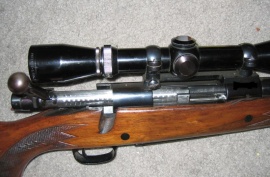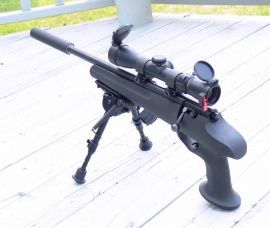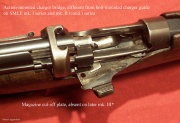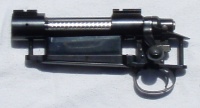Bolt action

The term bolt action refers to a type of firearm action in which the weapon's bolt is operated manually by the opening and closing of the breech with a small handle, most commonly placed on the right-hand side of the weapon. As the handle is operated, the bolt is unlocked, the breach is opened, the spent shell casing is withdrawn and ejected, and finally a new round/shell (if available) is placed into the breach and the bolt closed. Bolt action firearms are most often rifles, but there are some bolt-action shotguns as well. Examples of this system date back to the 19th century, and except for most sniper rifles and civilian use, have been largely replaced with semi-automatic weapons around the world.
Contents[hide] |
[edit] History

As early as 1803, breech-loading bolt-action rifles were produced. They continued to develop, following a steady progression, while seeing widespread adoption and continual improvements in design. By the mid 1800s and during the Civil War, bolt-action rifles were being used widely as cavalry weapons as well as for snipers. World War I marked the height of the bolt-action rifle's use, though automatic loading designs were introduced during the war.
During the build up prior to World War II, the military bolt-action rifle began to be superseded by the semi-automatic rifle and later assault rifles, though it remained the primary weapon of some (mostly Russian) infantry for the duration of the war. The bolt-action is still common today among sniper rifles, as the design has potential for superior accuracy, reliability, lesser weight, and the ability to control loading over the faster rate of fire that alternatives allow. There are however, many semi-automatic sniper rifle designs, especially in the designated marksmen role.
Today, bolt-action rifles are chiefly used as hunting rifles. These rifles can be used to hunt anything from vermin, to deer, to large game, especially big game caught on a safari, as they are adequate to deliver a single lethal shot from a safe distance.
Bolt-action shotguns are considered a rarity among modern firearms, but were formerly a commonly used action for .410 entry-level shotguns, as well as for low-cost 12 gauge shotguns. The XM26 Lightweight Shotgun System (LSS) is the most advanced and recent example of a bolt-action shotgun, albeit one designed to be attached to an M16 rifle or M4 carbine using an underbarrel mount (although with the standalone kit, the LSS can become a standalone weapon). Mossberg 12 gauge bolt-action shotguns were briefly popular in Australia after the 1997 firearms law changes, but the shotguns themselves were awkward to operate and only had a three-round magazine, thus offering no practical and real advantages over a conventional double-barrel shotgun.
Some pistols are bolt action, although this is uncommon, and such examples are typically specialised target handguns.
[edit] Major Bolt Action systems
There are three major bolt action system designs: the Mauser system, the Lee-Enfield system, and the Mosin-Nagant system. All differ in the way the bolt fits into the receiver, how the bolt rotates as it is being operated, the number of locking lugs holding the bolt in place as the gun is fired, and whether the action is cocked on the opening of the bolt (as in the Mauser system) or the closing of the bolt (as in the Lee-Enfield system). The vast majority of bolt-action rifles utilize one of these three systems, with other designs seeing only limited use.
[edit] Mauser
- Main article: Mauser
The Mauser bolt system was introduced in the Mauser Gewehr 98 and is the most common bolt action system in the world, being in use in nearly all modern hunting rifles and the majority of military bolt-action rifles until the middle of the 20th century (besides the Mauser K98, the Mauser bolt system was also used in the American M1903 Springfield rifle, the Japanese Arisaka Type 38 and Type 99 rifles, and the Anglo-American M1917 Enfield). The Mauser system is stronger than that of the Lee-Enfield because of the third locking lug present at the rear of the bolt, and is able to handle higher pressure cartridges (ie "Magnum" calibre centrefire rifle cartridges), unlike the Lee-Enfield or Mosin-Nagant actions. The Mauser system, due to its "cock on opening" operation (the upward rotation of the bolt when the rifle is opened cocks the action) has a slower rate of fire than the "cock on closing" systems used in the Lee-Enfield.
Versions of the Mauser action designed prior to the Gewehr 98's introduction, such as that of the Swedish Mauser rifles and carbines, lack the third locking lug and have "cock on closing" operation.
- Most modern hunting/sporting rifles like Remington 700 and Winchester Model 70
- Gewehr 98/Karabiner 98k
- M1903 Springfield
- Arisaka Type 38/Type 99
[edit] Lee-Enfield

- Main article: Lee-Enfield
The Lee-Enfield bolt action system was introduced in 1889 with the Lee-Metford and later Lee-Enfield rifles (the bolt system is named after the designer and the Royal Small Arms Factory at Enfield), and is a "cock on closing" action in which the forward thrust of the bolt cocks the action. This allows for a much faster rate of fire, but the system is unsuitable for use with modern "Magnum" calibre centrefire rifle cartridges. Interestingly, the Lee-Enfield bolt system features a removable bolthead, which allows the rifle's headspace to be adjusted by simply removing the bolthead and replacing it with one of a different length as required. In the years leading up to WWII, the Lee-Enfield bolt system was used in numerous commercial sporting and hunting rifles manufactured by such firms in the UK as BSA, LSA, and Parker-Hale, as well as by SAF Lithgow in Australia. Vast numbers of ex-military SMLE Mk III rifles were sporterised post-WWII to create cheap, effective hunting rifles, and the Lee-Enfield bolt system is used in the M10 and No 4 Mk IV rifles manufactured by Australian International Arms.
- Lee-Enfield (all marks and models)
- Ishapore 2A1
- Various hunting/sporting rifles manufactured by BSA, LSA, SAF Lithgow, and Parker-Hale
- Australian International Arms M10 and No 4 Mk IV hunting/sporting rifles
[edit] Mosin-Nagant
- Main article: Mosin-Nagant
The Mosin-Nagant, created in 1898, action differs from the Mauser and Lee-Enfield actions, in that it has a separate bolthead which rotates with the bolt and the bearing lugs, in contrast to the Mauser system where the bolthead is a non-removable part of the bolt are a single piece and rotate as such, or the Lee-Enfield system where the bolthead remains stationary and the bolt body rotates. The Mosin-Nagant bolt is a somewhat complicated affair, but is extremely rugged and durable. Like the Lee-Enfield bolt system, the Mosin-Nagant system is not suitable for use with modern "Magnum" calibre centrefire rifle cartridges, although it is worth noting that its standard Russian 180-grain 7.62x54R ammunition is comparable to some loads of the 7 mm Remington Magnum. Although the bolt system is not employed in any commercial sporting rifles, the Mosin-Nagant rifle is the most numerous bolt-action rifle ever produced and large numbers of them have been sporterised for use as hunting rifles in the years since WWII.
One interesting aspect of the Mosin-Nagant rifle's long and varied history is that of the wars for independence between Finland and the Soviet Union. Large numbers of these, some Russian, and some made by foreign coutries such as France and even America for Czarist Russia, were inherited and then re-worked by Finland into various models prior to WW2, all of them made vastly superior to more common examples of the M-N system. The Finnish M39 is widely considered to be one of the finest and most accurate military rifles ever produced.
[edit] Hybrids
Some rifles, such as the Swedish Mauser and the Pattern 1914 and M1917 Enfields, use a hybrid of the Mauser and Lee-Enfield systems.
The Model 96 and Model 38 Swedish Mausers, for example, use a Mauser bolt which is of a "cock on closing" closing design (giving it a faster rate of fire than the Mauser K98 or the M1903 Springfield, but still not quite as fast as the Lee-Enfield), whereas the Pattern 1914 Enfield uses a system whereby the action is half-cocked as the bolt is opened, with the forward thrust of the bolt on reloading fully cocking the rifle. The Pattern 1914 Enfield also uses safety of the Lee-Enfield, while the bolt itself is largely derived from the Mauser 98.
[edit] Other designs
In addition to the most common bolt action systems, others have been devised that failed to achieve the ubiquity of the Mauser, Lee-Enfield, and Mosin-Nagant designs. Some of the most notable of these are the Swiss Schmidt-Rubin and Austro-Hungarian Steyr-Mannlicher M1895 designs. Both are straight-pull bolt actions, but are entirely unrelated designs. The Schmidt-Rubin rifles feed from stripper clips, albeit of an unusual cardboard and steel design, while the Steyr-Mannlicher uses en-bloc clips. The Schmidt-Rubin series, which culminated in the K31, are also known for being among the most accurate military rifles ever made.
Another notable design is the Norwegian Krag-Jørgensen, which was used by Norway, Denmark, and briefly the United States. It is unusual among bolt action rifles in that is loaded through a gate on right side of the receiver, and thus can be reloaded without opening the bolt. The Norwegian and Danish versions of the Krag have two locking lugs, while the American version has only one. In all versions, the bolt handle itself serves as an emergency locking lug. The Krag's major disadvantage compared to other bolt-action designs is that it must be loaded by hand, one round at a time. This made it slower to reload than other designs which used stripper or en-bloc clips. Another historically important bolt action rifle is the French Mle 1886 Lebel rifle which was first to introduce ammunition loaded with nitrocellulose-based smokeless powder.
[edit] Operating the bolt
Typically, the bolt consists of a tube of metal inside of which the firing mechanism is housed, and which has at the front or rear of the tube several metal knobs, or "lugs", which serve to lock the bolt in place. The operation can be done via a rotating bolt, a lever, or a number of systems. For example, one setup is a straight-pull design, such as the German Blaser R93 rifle. Straight-pull designs have seen a great deal of use, though manual turn-bolt designs are what is most commonly thought of in reference to a bolt-action design due to the type ubiquity. As a result the bolt-action term is often reserved for more modern types of rotating bolt-designs when talking about a specific weapon's type of action, however both straight-pull and rotating bolt rifles are types of bolt-action rifles. Lever-action and pump-action weapons must still operate the bolt, but they are usually grouped separately from bolt-actions that are operated by a handle directly attached to a rotating bolt.
[edit] Loading
Most bolt-action firearms are fed by an internal magazine loaded by hand, by en bloc, or stripper clips, though a number of designs have had a detachable magazine or independent magazine, or even no magazine at all, thus requiring that each round be independently loaded. Generally, the magazine capacity is limited to three to ten rounds, as it can permit the magazine to be flush with the bottom of the rifle, reduce the weight, or prevent mud and dirt from entering. A number of bolt-actions have a tube magazine, such as along the length of the barrel. In weapons other than large rifles, such as pistols and cannons, there were some manually operated breech loading weapons. However, the Dreyse Needle fire rifle was the first breech-loader to use a rotating bolt design. Johann Nicholas von Dreyse's rifle of 1838 was accepted into service by Prussia in 1841, which was in turn developed into the Prussian Model 1849. The design was a single-shot breech loader, and had the now familiar arm sticking out the bolt to turn and open the chamber. The entire reloading sequence was a more complex procedure than later designs, however, as the firing pin had to be independently primed and activated, and the lever was only used to move the bolt.
[edit] Benefits and Drawbacks
Bolt-action firearms have earned a reputation for being more powerful and accurate than any semiautomatic rifle. For this reason, they are still the choice of many target shooters and snipers. This is true because of the way that bolt action rifles close the chamber. When a bullet fires inside the chamber, the force from the charge is completely directed at propelling the bullet down the barrel (In an autoloader, part of the energy is used to cycle the action). Also, a bolt action's only moving parts when firing are the pin and spring. Since it has fewer moving parts and a short lock time, it has less of a chance of being thrown off target and less of a chance to jam. Finally, since the spent cartridge has to be manually removed instead of automatically ejected, it helps a sniper remain better hidden, since not only is the cartridge not flung into the air and to the ground, possibly giving away the sniper's position, but the cartridge can be removed when most prudent, allowing the sniper to remain still until reloading is tactically feasible. Bolt actions are also easier to operate from a prone position than other manually repeating mechanisms and work well with box magazines which are easier to fill and maintain than tubular magazines.
Some disadvantages of the bolt action include being the slowest of all the major manual repeating mechanisms, as it requires four distinct movements (as opposed to two for lever and pump action, though straight-pull bolt actions likewise require only two movements) and requires the trigger hand leave the gun and regrip the weapon after each shot, usually resulting in the shooter having to realign his sight and reacquire the target for every shot. It is also not ambidextrous.
[edit] Safety and Headspace
On used bolt-action firearms, especially, the headspace should be checked prior to shooting, to ensure it is correct, to prevent over-stressing chambers and cartridge brass. Some bolt-action rifles, such as the Lee-Enfield, have a series of different length bolts available to extend the service life of the rifle, for taking up any wear of the bolt and chamber occurring from long years of service.
[edit] See also
- Krag-Jørgensen
- K31
- Carcano
- M1903 Springfield rifle
- British military rifles
- Spencer repeating rifle
- Winchester Model 70
- Remington 700
- Browning A-Bolt
- Antique guns
- Lever action
- Pump action
- Blowback
- Gas-operated
- Recoil operation
- Lebel rifle
[edit] External links
- [1]: Mosin-Nagant rifles (all marks and models)
